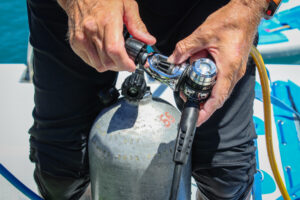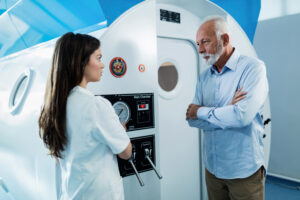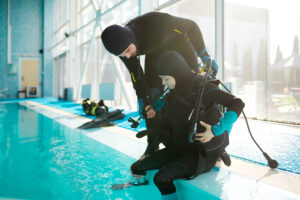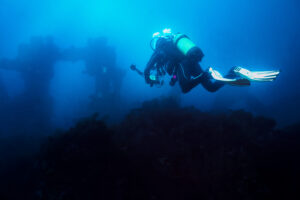ABT (Actual Bottom Time)
Introduction
ABT, or Actual Bottom Time, is a term that has become second nature to many in the scuba diving community, yet its importance may not be immediately evident to novices. ABT is the exact duration from the moment a diver begins their descent until the start of their ascent. It is a crucial aspect of dive planning and safety, deeply woven into the fabric of the sport. This entry aims to provide an in-depth exploration of ABT, its significance, calculation, and factors influencing it.
The Significance of ABT
Safety First
ABT plays a central role in ensuring the safety of divers. It helps in determining decompression stops, which are essential to prevent decompression sickness (DCS), also known as ‘the bends.’ DCS is a condition that can occur when a diver ascends too quickly, causing dissolved gases in the body’s tissues to form bubbles. By keeping track of ABT, divers can adhere to appropriate ascent rates and decompression stops, effectively mitigating the risk of DCS.
The measurement of ABT also facilitates safer dives by helping divers manage their air supply. Knowing the duration of a dive allows divers to calculate their air consumption rate, which is vital in planning dive durations and managing reserves.
Log Books and Dive Planning
ABT is a standard entry in most diver log books. By recording their ABT, divers can track their experiences and growth, and it serves as a record of their underwater adventures. These records can be instrumental in planning future dives, especially when diving in similar conditions or revisiting sites. Detailed log entries with ABT can also assist in the training and certification process, providing tangible evidence of a diver’s experience and competence.
Calculation of ABT
Beginning of Descent
The start of ABT is marked by the commencement of the descent. This is the moment when the diver leaves the surface with the intent to dive. It’s important to note that surface swims or surface intervals before the dive are not included in the ABT.
Beginning of Ascent
The end point of the ABT is the beginning of the ascent, which is when the diver makes a deliberate decision to return to the surface. It’s vital to remember that the ascent includes any safety or decompression stops that may be required.
Factors Influencing ABT
Diver’s Physical Condition and Expertise
The diver’s physical condition and experience significantly influence the ABT. Divers with excellent buoyancy control and underwater navigation skills can extend their ABT by reducing unnecessary movements and conserving air. Similarly, a diver in good physical shape can manage air consumption more effectively, allowing for a longer ABT.
Environmental Conditions
The diving environment also directly impacts ABT. Factors such as water temperature, current strength, and visibility can affect a diver’s air consumption rate and, consequently, their ABT. Colder water can lead to increased air consumption due to physiological responses such as shivering, while strong currents might force a diver to work harder, consuming more air.
Advanced Considerations
Multilevel Diving and ABT
In multilevel diving, where divers spend time at different depths during a single dive, ABT becomes a bit more complex. Here, divers use a multilevel dive planner or dive computer that considers the varying pressure levels experienced throughout the dive. In this context, ABT still marks the total time from descent to ascent, but the decompression requirements are calculated differently.
Technical Diving and ABT
In technical diving, which often involves dives beyond recreational depth limits or inside overhead environments, managing ABT is crucial. Tech divers often use enriched air mixtures or even multiple gas mixes during a dive, making accurate tracking of
ABT even more critical. Here, ABT is used not only to calculate decompression stops but also to plan gas switches at different stages of the dive. An error in ABT calculation could lead to inappropriate gas mixes being used at certain depths, which could result in serious complications, including oxygen toxicity or nitrogen narcosis.
No-Decompression Limit and ABT
The No-Decompression Limit (NDL) is the maximum time a diver can spend at a specific depth without needing decompression stops during the ascent. ABT is used to ensure that the diver does not exceed the NDL at a given depth. If the ABT exceeds the NDL, the dive becomes a decompression dive, and the diver must make one or more decompression stops on the way to the surface.
ABT in Diver Education and Certification
Training Agencies and ABT
ABT plays a significant role in diver education. Most training agencies, such as PADI, NAUI, and SSI, incorporate ABT in their training manuals and certification requirements. Understanding, calculating, and recording ABT is a skill that is developed early in diver training and honed throughout a diver’s career.
ABT in Diver Specialties
Several diver specialties, such as deep diving, wreck diving, and cave diving, have particular emphasis on accurate ABT management. These environments often require more complex dive planning and stricter adherence to ABT due to increased risks and challenges.
Practical Tips for ABT Management
Use of Dive Computers
Modern dive computers are a valuable tool for managing ABT. These devices automatically track the duration of the dive from the moment of descent to the beginning of the ascent, removing the need for manual timing. They also adjust decompression requirements in real-time, considering factors such as depth changes and ascent speed.
Buddy Checks and Communication
Buddy checks and communication can greatly aid in accurate ABT management. Divers should regularly communicate their remaining air and dive time to their buddy. In the case of a discrepancy in ABT between buddies, it’s always safer to plan the rest of the dive based on the shortest ABT.
Final Remarks
ABT is a fundamental concept in scuba diving, entwined with the very principles of safety, planning, and enjoyment in the sport. Its influence extends from the individual diver’s experience right up to advanced technical diving and professional level training. By understanding and effectively managing ABT, divers unlock the ability to explore the underwater world with confidence and security. In the vast ocean of scuba diving knowledge, ABT stands as a beacon, guiding divers to safe and successful underwater adventures.
ABT in Recreational and Technical Diving Gear
Dive Watches and ABT
Traditional dive watches can also be used to keep track of ABT. While not as advanced or accurate as modern dive computers, they provide a manual way of tracking time underwater. It’s crucial for divers choosing this method to have a firm understanding of their planned dive profile and the necessary decompression stops.
Gas Planning and ABT
In both recreational and technical diving, gas planning is inseparable from ABT. Divers must plan their gas supply to last for the entire ABT, including a reserve. This planning becomes more complex in technical diving, where divers might switch between different gas mixes, each calculated based on the planned ABT at different depths.
ABT in Dive Accidents and Incidents
ABT and Diving Incidents
Many diving incidents are related to improper management of ABT. Overstaying the planned ABT can lead to low-on-air or out-of-air situations, forced rapid ascents, missed decompression stops, and even decompression sickness. These incidents highlight the importance of proper ABT planning and adherence.
Role of ABT in Dive Accident Analysis
ABT plays a crucial role in the analysis of dive accidents. By reviewing the ABT along with other factors such as depth, gas mix used, and diver actions, investigators can reconstruct the events leading up to an accident. This not only aids in understanding the cause of the accident but also helps in developing safety guidelines and training material to prevent similar incidents in the future.
Diving Innovations and Future of ABT
Impact of Technology on ABT Management
The advancement of technology has greatly simplified ABT management. Modern dive computers can now adjust for multilevel dives, track ascent rates, calculate decompression stops, and even account for different gas mixes. Future innovations may bring even more sophisticated methods of tracking and calculating ABT, further enhancing diver safety and convenience.
Evolving Practices and ABT
As diving practices evolve, so does the approach to ABT. For instance, in the growing field of technical and rebreather diving, divers are spending longer periods underwater, leading to more complex ABT calculations. The evolution of dive practices and equipment will continue to shape the understanding and application of ABT in the years to come.
In the world of scuba diving, ABT continues to be a key component. It is intricately tied to safety, planning, enjoyment, and the evolution of the sport. As divers, our comprehension and management of ABT not only enable us to embark on thrilling underwater explorations but also ensure that we can do so with the utmost respect for our personal safety and the underwater environment we so deeply cherish.
ABT in Different Diving Environments
Cold Water Diving and ABT
Cold water diving presents unique challenges that can influence ABT. Divers in cold water often consume air faster due to physiological responses such as shivering and increased metabolic rate. Equipment such as dry suits and regulators can also perform differently in cold conditions, affecting ABT. Proper planning and equipment checks are crucial to manage ABT effectively in these environments.
Altitude Diving and ABT
Altitude diving, or diving in bodies of water located at higher altitudes, requires special considerations when it comes to ABT. The reduced atmospheric pressure at altitude affects the body’s decompression, meaning that divers need to adjust their dive profiles and decompression calculations. Most dive computers have an altitude setting, but divers also need to understand how altitude affects their ABT and plan accordingly.
ABT and Underwater Activities
Underwater Photography and ABT
Underwater photographers need to be mindful of their ABT as they navigate and position themselves to capture the perfect shot. It’s easy to lose track of time while focusing on subjects, and divers can find themselves overstaying their planned ABT. Efficient air consumption and good buoyancy control can help photographers maximize their ABT without compromising safety.
Scientific Diving and ABT
In scientific diving, tasks such as data collection, sampling, or underwater archaeology often require precise timing, making ABT a crucial factor. Moreover, scientific divers often carry additional equipment, which can influence their buoyancy and air consumption. As such, ABT planning in scientific diving involves not only the dive itself but also the tasks to be performed underwater.
ABT in Conservation and Marine Biology
ABT in Marine Biological Studies
In marine biology and conservation studies, divers often spend extended periods underwater observing, tagging, or collecting specimens. Accurate tracking of ABT is crucial to ensure the safety of the divers and the wellbeing of the marine life they interact with. ABT also helps in planning the timing and duration of specific observations or tasks.
Coral Reef Conservation and ABT
In coral reef conservation efforts, divers are often involved in activities like reef cleanups, coral planting, or monitoring. These activities require careful planning of ABT to ensure that divers can complete their tasks without running low on air or needing unplanned decompression stops. The ABT also aids in scheduling these activities to minimize disturbance to the reef and its inhabitants.
In the fascinating realm of scuba diving, ABT remains a cornerstone of safe and successful dives. It bridges the gap between the thrill of exploration and the paramount importance of safety. From the novice diver to the seasoned explorer, understanding and managing ABT is a skill that serves throughout one’s diving journey, opening the doors to the captivating wonders beneath the waves.
ABT in Different Diving Disciplines
Cave Diving and ABT
Cave diving, one of the most challenging disciplines in scuba diving, demands precise ABT management. In an environment where direct ascent to the surface is not possible, divers must ensure they have enough air to exit the cave, taking into account the ABT required to navigate out safely. Cave divers also often make use of advanced techniques like stage decompression and gas switching, making ABT calculation a complex but crucial task.
Wreck Diving and ABT
Wreck diving also requires careful ABT management. Divers often navigate through tight spaces and can be exposed to hazards like sharp edges or entanglement risks, which can affect air consumption and, therefore, ABT. Moreover, wreck divers must plan their ABT to allow enough time for exploration, while ensuring safe ascent and any required decompression.
ABT and Environmental Impact
Sustainable Diving Practices and ABT
Sustainable diving practices aim to minimize the environmental impact of diving activities. Proper ABT management contributes to this goal by helping divers avoid unnecessary stress or damage to marine life. By planning their ABT efficiently, divers can take the time to observe and interact with the underwater environment responsibly, ensuring they do not overstay their welcome or cause disturbance.
ABT and Marine Protected Areas
In marine protected areas (MPAs), strict guidelines often govern diving activities, including limitations on dive duration or ABT. These guidelines are designed to protect sensitive ecosystems from potential harm caused by prolonged human presence. Adhering to the specified ABT in MPAs is not only a matter of safety but also a commitment to the conservation of these precious underwater habitats.
In Perspective
Diving is not merely a sport or recreational activity, but a dance with nature, a means of exploring a world unseen by most. At the heart of this exploration lies ABT, a simple concept that holds immense significance. From ensuring our safety to shaping our interactions with the underwater world, ABT guides us throughout our diving journey.
Whether we’re gliding through a vibrant coral reef, navigating the eerie silence of a sunken ship, or marveling at the surreal beauty of an underwater cave, ABT remains our constant companion. It helps us cherish each moment underwater while keeping a vigilant eye on our lifeline to the surface world.
As we continue to innovate and push the boundaries of diving, ABT will continue to evolve with us, adapting to new technologies, techniques, and challenges. Yet, its essence will remain the same: a measure of time that embodies our respect for the sea and our dedication to exploring it safely and responsibly. It is a testament to our understanding that every dive is a privilege, every minute underwater a gift, and every breath a reminder of our connection to the life-giving force of the ocean.
















